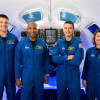Astronomers bid farewell to Saturn spacecraft

Global astronomers bid farewell Friday to NASA's famed Cassini spacecraft, which launched 20 years ago to circle Saturn and transformed the way we think about life elsewhere in the solar system.
Cassini, an international project that cost $3.9 billion and included scientists from 27 nations, has run out of rocket fuel as expected after a journey of some 4.9 billion miles (7.9 billion kilometers).
Its death plunge into the ringed gas giant -- the furthest planet visible from Earth with the naked eye -- is scheduled for shortly after the spacecraft's final contact with Earth at 7:55am (1155 GMT).
Cassini's well-planned demise is a way of preventing any damage to Saturn's ocean-bearing moons Titan and Enceladus, which scientists want to keep pristine for future exploration because they may contain some form of life.
"It will be sad to see Cassini go on Friday, especially as the instrument we built is still working perfectly," said Stanley Cowley, professor of solar planetary physics at the University of Leicester.
"But we recognize that it is important to bring the mission to an end in a tidy and controlled manner."
Three other spacecraft have flown by Saturn -- Pioneer 11 in 1979, followed by Voyager 1 and 2 in the 1980s.
But none have studied Saturn in such detail as Cassini, named after the French-Italian astronomer Giovanni Domenico Cassini, who discovered in the 17th century that Saturn had several moons and a gap in between its rings.
Discoveries
Cassini launched from Cape Canaveral, Florida in 1997, then spent seven years in transit followed by 13 years orbiting Saturn.
In that time, it discovered six more moons around Saturn, three-dimensional structures towering above Saturn's rings, and a giant storm that raged across the planet for nearly a year.
The 22 by 13 foot (6.7 by four meter) spacecraft is also credited with discovering icy geysers erupting from Saturn's moon Enceladus, and eerie hydrocarbon lakes made of ethane and methane on Saturn's largest moon, Titan.
In 2005, the Cassini orbiter released a lander called Huygens on Titan, marking the first and only such landing in the outer solar system, on a celestial body beyond the asteroid belt.
Huygens was a joint project of the European Space Agency, Italian Space Agency and NASA.
"The mission has changed the way we think of where life may have developed beyond our Earth," said Andrew Coates, head of the Planetary Science Group at Mullard Space Science Laboratory at University College London.
"As well as Mars, outer planet moons like Enceladus, Europa and even Titan are now top contenders for life elsewhere," he added.
"We've completely rewritten the textbooks about Saturn."
Some 4,000 scientific papers have been based on data from the mission, said Mathew Owens, professor of space physics at the University of Reading.
And its final plunge will reveal even more about the make-up of Saturn's atmosphere before Cassini disintegrates like a meteor.
"No doubt scientists will be analyzing the information from its final, one-way trip into Saturn's atmosphere for years to come," Owens said.

 For all latest news, follow The Daily Star's Google News channel.
For all latest news, follow The Daily Star's Google News channel. 








Comments